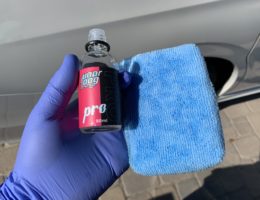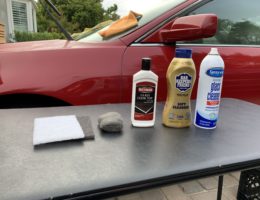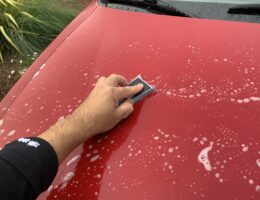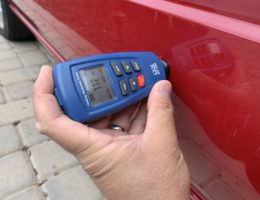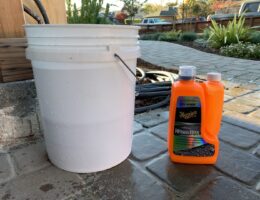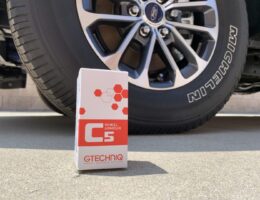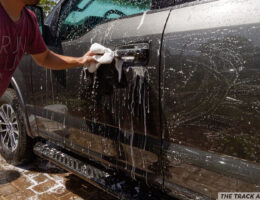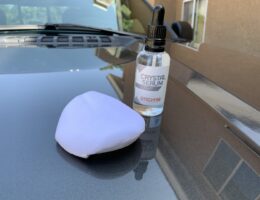When removing old decals off of your car, there are two stages to doing it. The first is the safe and effective removal of the decal, and the second is the elimination of decal residue. The decal residue can make a “ghost image” appear even though the window looks clean and free of residue. The longer the decal has been on the glass, the more likely you will having this “ghosting” effect left behind.
There’s one major thing I love about Undrdog Pro Coating and that is how easy it is to apply, even when you doing it outside. Since I don’t have a sheltered parking spot, nor a large enough of a garage to park a car, applying a ceramic coating (with its inherent finicky flash times) outdoors can be tricky. But with Undrdog Pro, I never felt the product dry up or flash too quickly; it just went on and buffed off effortlessly. So for now, I’m incredibly happy with this product, but the real test is how long this product lasts.
There’s more than one way to do a deep clean on your car’s windows. There’s the method of using an abrasive like a polish such as Bar Keeper’s Friend or Weiman Cooktop Cleaner if you already own these household items. However, my preference for cleaning windows is to use either 0000 steel wool or a white scotch pad along with glass cleaner.
On this guide, I’m focusing on removing heavy orange peel and the techniques used to do this. Typically the process involves sanding or wet-sanding the vehicle from lower to higher grit, then following up with an aggressive compound to buff/polish the small scratches out. I will be demonstrating both dry and wet-sanding techniques, as well as following up with a Meguiar’s compound, microfiber cutting pad, and a long throw polisher to finish it off.
Instead of spending hundreds to thousands of dollars on an ultrasonic paint thickness gauge, we can instead use an affordable magnetic/Eddy-current gauge as long as we have an understanding what the typical layers on a modern day car are, what the thickness of these layers are. By knowing the typical thickness of each layer that encompasses a “paint job”, we can have a general idea of how much clear coat we have before we wear down to the paint, primer, or even substrate.
Meguiar’s Hybrid Ceramic Wash and Wax is different from your traditional “wash ‘n wax” product that traditionally combines soap and wax into one. This product separates both car soap and wax into two separate chambers in its packaging: a larger one containing a low-sudsing soap to gently clean the vehicle, and a smaller one with the wax additive that exhibits excellent hydrophobic properties. This guide on how to use Meguiar’s Hybrid Ceramic Wash & Wax is intended to help supplement the provided instructions from Meguiar’s and to provide some helpful tips and tricks to getting the most out of this product based on my own experiences. A big thank you to Meguiar’s for providing this product for me to test and write about.
Gtechniq makes a wheel coating called C5 Wheel Armour that not only protects wheels (and brake calipers), but also minimizes brake dust and dirt from sticking to the surface that it is applied to. A wheel coating may differ from a ceramic coating due to its ability to withstand higher temperatures—temperatures that can be seen coming from the brakes of a car. In this post, I show the preparation and application of Gtechniq C5 Wheel Armour to a set of wheels, as well as how easy it is to wash later down the road.
So you’ve just ceramic coated your car or perhaps a car detailer ceramic coated your car for you. Now, you may be wanting to know how to wash and maintain it properly. Contrary to what some people may believe, ceramic coatings are not some mysterious product that needs extra special care. It simply just needs to be washed with proper wash techniques and with the right car wash products.
Ceramic coatings have become all the rage in recent years with quite a few options becoming available for the consumer market. These coatings form a very strong bond (on the nano scale) to your car’s paint leaving a layer of protection that is thicker and longer-lasting than your typical wax or paint sealant. Ceramic coatings offer protection against light scratches, corrosion, heat, chemicals, environmental effects, and industrial fallout. In addition to protection from the elements, ceramic coatings also offer superb hydrophobic properties which makes it much easier to wash your car.


